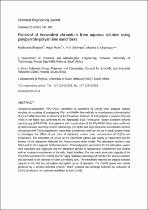 ResearchSpace
ResearchSpace
Removal of hexavalent chromium from aqueous solution using polypyrrole-polyaniline nanofibers
JavaScript is disabled for your browser. Some features of this site may not work without it.
- ResearchSpace
- →
- Research Publications/Outputs
- →
- Journal Articles
- →
- View Item
| dc.contributor.author |
Bhaumik, M

|
|
| dc.contributor.author |
Maity, Arjun

|
|
| dc.contributor.author |
Srinivasu, VV

|
|
| dc.contributor.author |
Onyango, MS

|
|
| dc.date.accessioned | 2013-02-04T07:57:52Z | |
| dc.date.available | 2013-02-04T07:57:52Z | |
| dc.date.issued | 2012-02 | |
| dc.identifier.citation | Bhaumik, M, Maity, A, Srinivasu, V.V and Onyango, M.S. 2012. Removal of hexavalent chromium from aqueous solution using polypyrrole-polyaniline nanofibers. Chemical Engineering Journal, vol. 181-182, pp 323-333 | en_US |
| dc.identifier.issn | 1385-8947 | |
| dc.identifier.uri | http://www.sciencedirect.com/science/article/pii/S1385894711014902 | |
| dc.identifier.uri | http://hdl.handle.net/10204/6519 | |
| dc.description | Copyright: 2012 Elsevier. This is an ABSTRACT ONLY. The definitive version is published in Chemical Engineering Journal, vol. 181-182, pp 323-333 | en_US |
| dc.description.abstract | Polypyrrole-polyaniline (PPy-PANI) nanofibers as adsorbent of Cr(VI) were prepared without template via coupling of propagating PPy+ and PANI+ free radicals by simultaneous polymerization of Py and ANI monomers in presence of FeCl3 oxidant. Inclusion of both polymeric moieties PPy and PANI in the fibers was confirmed by the Attenuated Total Reflectance Fourier transform infrared spectroscopy (ATR-FTIR). Entanglement and nanostructure of the PPy-PANI fibers were confirmed by field-emission scanning electron microscopy (FE-SEM) and high-resolution transmission electron microscopy (HR-TEM) respectively. Adsorption experiments were carried out in batch sorption mode to investigate the effect of pH, dose of adsorbent, contact time, concentration of Cr(VI) and temperature. The adsorption of Cr(VI) on the nanofibers surface was highly pH dependent and the kinetics of the adsorption followed the Pseudo-second-order model. The adsorption isotherm data fitted well to the Langmuir isothermal model. Thermodynamic parameters for the adsorption system were calculated and suggested that the adsorption process is spontaneous, endothermic and marked with an increase in randomness at the solid–liquid interface. The maximum adsorption capacity of the PPy-PANI nanofibers for Cr(VI) was 227 mg/g. Selective adsorption of Cr(VI) from aqueous solution was achieved in the presence of other co-existing ions. The nanofibers retained the original sorption capacity in the first two adsorption–desorption cycles of operation. The Cr(VI) uptake was mainly governed by a physico-chemical process, which included ion-exchange followed by reduction of Cr(VI) by electron rich polymer nanofibers to form Cr(III). | en_US |
| dc.language.iso | en | en_US |
| dc.publisher | Elsevier | en_US |
| dc.relation.ispartofseries | Workflow;8186 | |
| dc.subject | Polypyrrole-polyaniline | en_US |
| dc.subject | Nanofibers | en_US |
| dc.subject | Hexavalent chromium | en_US |
| dc.subject | Equilibrium | en_US |
| dc.subject | Kinetics | en_US |
| dc.title | Removal of hexavalent chromium from aqueous solution using polypyrrole-polyaniline nanofibers | en_US |
| dc.type | Article | en_US |
| dc.identifier.apacitation | Bhaumik, M., Maity, A., Srinivasu, V., & Onyango, M. (2012). Removal of hexavalent chromium from aqueous solution using polypyrrole-polyaniline nanofibers. http://hdl.handle.net/10204/6519 | en_ZA |
| dc.identifier.chicagocitation | Bhaumik, M, Arjun Maity, VV Srinivasu, and MS Onyango "Removal of hexavalent chromium from aqueous solution using polypyrrole-polyaniline nanofibers." (2012) http://hdl.handle.net/10204/6519 | en_ZA |
| dc.identifier.vancouvercitation | Bhaumik M, Maity A, Srinivasu V, Onyango M. Removal of hexavalent chromium from aqueous solution using polypyrrole-polyaniline nanofibers. 2012; http://hdl.handle.net/10204/6519. | en_ZA |
| dc.identifier.ris | TY - Article AU - Bhaumik, M AU - Maity, Arjun AU - Srinivasu, VV AU - Onyango, MS AB - Polypyrrole-polyaniline (PPy-PANI) nanofibers as adsorbent of Cr(VI) were prepared without template via coupling of propagating PPy+ and PANI+ free radicals by simultaneous polymerization of Py and ANI monomers in presence of FeCl3 oxidant. Inclusion of both polymeric moieties PPy and PANI in the fibers was confirmed by the Attenuated Total Reflectance Fourier transform infrared spectroscopy (ATR-FTIR). Entanglement and nanostructure of the PPy-PANI fibers were confirmed by field-emission scanning electron microscopy (FE-SEM) and high-resolution transmission electron microscopy (HR-TEM) respectively. Adsorption experiments were carried out in batch sorption mode to investigate the effect of pH, dose of adsorbent, contact time, concentration of Cr(VI) and temperature. The adsorption of Cr(VI) on the nanofibers surface was highly pH dependent and the kinetics of the adsorption followed the Pseudo-second-order model. The adsorption isotherm data fitted well to the Langmuir isothermal model. Thermodynamic parameters for the adsorption system were calculated and suggested that the adsorption process is spontaneous, endothermic and marked with an increase in randomness at the solid–liquid interface. The maximum adsorption capacity of the PPy-PANI nanofibers for Cr(VI) was 227 mg/g. Selective adsorption of Cr(VI) from aqueous solution was achieved in the presence of other co-existing ions. The nanofibers retained the original sorption capacity in the first two adsorption–desorption cycles of operation. The Cr(VI) uptake was mainly governed by a physico-chemical process, which included ion-exchange followed by reduction of Cr(VI) by electron rich polymer nanofibers to form Cr(III). DA - 2012-02 DB - ResearchSpace DP - CSIR KW - Polypyrrole-polyaniline KW - Nanofibers KW - Hexavalent chromium KW - Equilibrium KW - Kinetics LK - https://researchspace.csir.co.za PY - 2012 SM - 1385-8947 T1 - Removal of hexavalent chromium from aqueous solution using polypyrrole-polyaniline nanofibers TI - Removal of hexavalent chromium from aqueous solution using polypyrrole-polyaniline nanofibers UR - http://hdl.handle.net/10204/6519 ER - | en_ZA |





